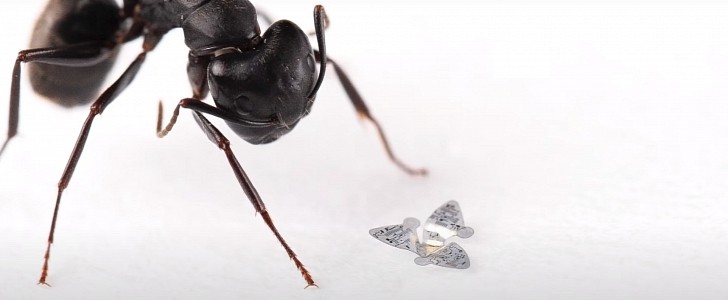A team of engineers boasts of beating nature by creating the smallest human-made flying structure, a winged microchip that behaves just like the seeds from trees and plants but has better flying capabilities.
The accomplishment belongs to a team of scientists at the Northwestern University in Illinois, who developed the microflier, a flying microchip that spins like a helicopter. This thing’s the size of a grain of sand but with small wings and an aerodynamic design that allows it to fall in a controlled manner thanks to its barely visible propellers.
How does that work? Well, the engineers used nature’s “manual” to get their inspiration for the microflier, analyzing the behavior of various types of wind-dispersed seeds. Instead of using a motor or engine, the tiny flying microchip uses the power of the wind to catch a flight, spinning through the ground at a low velocity. It is a stable flight, and the microflier can stand in the air for a long time, which is why it could prove to be useful for a variety of applications.
While nature has designed seeds with very sophisticated aerodynamics, the Northwestern team claims its microflier is better, as it is even smaller and its structure allows it to fall with more stable trajectories and at slower speeds than equivalent seeds from plants or trees.
The engineers built the flying structure to be used for purposes such as monitoring air pollution, population surveillance, contamination monitoring, disease tracking, to give just a few examples. And while this might look like a simple, limited device right now, researchers see its potential of becoming a highly functional, miniaturized electronic device. The microflier can be equipped with really sophisticated technology, such as tiny sensors, antennas for wireless communication, or embedded memory for data storage.
As far as the disposal of these electronics goes, once they are no longer needed, the team also has an environmentally responsible plan. These miniature components would be transient electronics made of degradable polymers and dissolvable integrated circuit chips that naturally degrade when exposed to water, according to John Roger, a pioneer in bioelectronics and the leader of the project.
How does that work? Well, the engineers used nature’s “manual” to get their inspiration for the microflier, analyzing the behavior of various types of wind-dispersed seeds. Instead of using a motor or engine, the tiny flying microchip uses the power of the wind to catch a flight, spinning through the ground at a low velocity. It is a stable flight, and the microflier can stand in the air for a long time, which is why it could prove to be useful for a variety of applications.
While nature has designed seeds with very sophisticated aerodynamics, the Northwestern team claims its microflier is better, as it is even smaller and its structure allows it to fall with more stable trajectories and at slower speeds than equivalent seeds from plants or trees.
The engineers built the flying structure to be used for purposes such as monitoring air pollution, population surveillance, contamination monitoring, disease tracking, to give just a few examples. And while this might look like a simple, limited device right now, researchers see its potential of becoming a highly functional, miniaturized electronic device. The microflier can be equipped with really sophisticated technology, such as tiny sensors, antennas for wireless communication, or embedded memory for data storage.
As far as the disposal of these electronics goes, once they are no longer needed, the team also has an environmentally responsible plan. These miniature components would be transient electronics made of degradable polymers and dissolvable integrated circuit chips that naturally degrade when exposed to water, according to John Roger, a pioneer in bioelectronics and the leader of the project.







